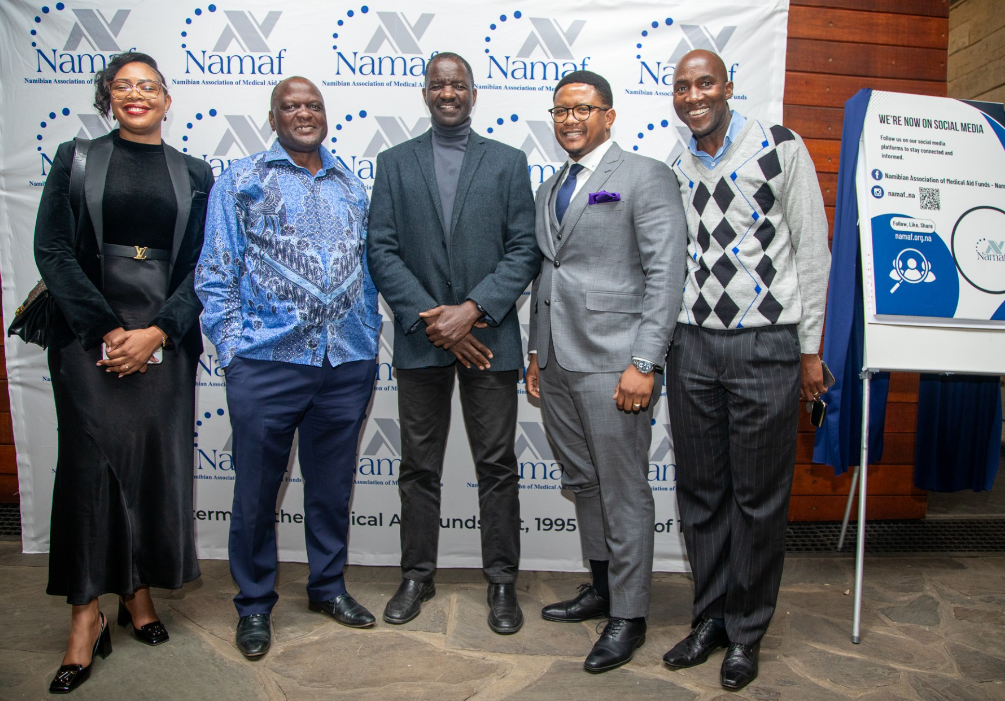Omanyano ovanhu koikundaneki yomalungula kashili paveta, Commisiner Sakaria takunghilile
Veronika Haulenga
Omanyano ovanhu koikundaneki yomalungula kashili paveta, Commisiner Sakaria takunghilile
Veronika Haulenga
Listeners:
Top listeners:
-
play_arrow
Omanyano ovanhu koikundaneki yomalungula kashili paveta, Commisiner Sakaria takunghilile Veronika Haulenga


According to the Namibian Constitution and its supporting legislation, the Minister of Health and Social Services is responsible for ensuring that the Namibian population has accessible, affordable, and appropriate healthcare.
Namibia has a pluralistic health system with the public sector as the main actor, funded through the public budget by money appropriated by Parliament in the National budget and privately funded healthcare system through Medical Aid Funds by those who are largely employed, save for Public Servants whose healthcare is funded by the Public Service Employee Medical Scheme.
The healthcare system is serviced by healthcare providers registered to practice their profession as determined in the various legislations under the Health Professions Council of Namibia (HPCNA).
Medical Aid Funds are a creature of the Medical Aid Funds Act of 1995 (Act No. 23 of 1995). The Seven (7) registered Funds comprise the young, old, and sickly who stand in solidarity and cross-subsidize one another when needing healthcare.
In terms of the Medical Aid Fund Act of 1995, the purpose of a Fund is to provide financial or other assistance to the members of the fund and their dependents in defraying expenditure incurred by them in connection with the rendering of any medical service but excludes insurance policy.
Funds perform a social security function and, therefore, do not make a profit as any surplus is invested to cater for the drought period. In fact, the Act 1995 prohibits the sharing of surpluses amongst members.
Healthcare is emotive and complex, as each stakeholder has a unique interest. Members of Medical Aid Funds expect all their care to be fully funded by Funds, while providers expect to be remunerated fairly and reasonably by Funds.
On the other hand, funds operate on a budget and manage money in the pool with sustainability in mind. Members of Funds elect amongst themselves the Board of Trustees, who are responsible for the governance and decision-making at the individual fund level.
The Board approves Fund rules that are binding between the Fund and members, including benefits that members choose from for their coverage.
The Board of Trustees appoints a Principal Officer, the accounting officer responsible for the Fund’s day-to-day management. In Namibia, the administration of Funds is outsourced to Fund Administrators, who act as agents of Funds.
Fund Administrators are responsible for the appropriateness of care and levels of care, member verification, application of Namaf Billing rules and guidelines, claims adjudication, payment of claims, and query handling.
In turn, Administrators are paid fees for administrative services provided to each Fund in terms of their Service Level Agreements. The Act of 1995 established Namaf and NAMFISA to regulate the interests of members of medical aid funds.
The Chief Executive Officer of NAMFISA is the registrar and is also responsible for prudential supervision of Funds, while Namaf, on the other hand, is responsible for clinical risk regulation of funds.
Namaf comprises all seven registered Funds, and its statutory object is to control, promote, encourage, and coordinate the establishment, development, and functioning of funds in Namibia.
Namaf controls the functioning of Funds by issuing practice numbers to providers who desire the claims to be paid by Funds. The purpose of practice is to identify the provider in claims adjudication by Funds.
Whereas NAMAF does not regulate providers of healthcare services, a practice number gives the holder access to the diagnostic codes, procedure codes, billing rules and guidelines, and NAPPI codes for medicines and surgical consumables prescribed by providers to members.
A practice number also gives access to benchmark tariffs, which serve as the reasonable cost for all coded medical services. Benchmark tariffs are not prescribed tariffs, as each fund decides whether to charge a percentage below or above the benchmark tariff.
Providers also decide whether to charge below or above the benchmark tariff. All funds provide claims data to Namaf through its appointed clinical consultants for retrospective analysis.
Namaf uses claims trend analysis reports to make industry decisions on various factors affecting Funds and determines whether providers are deploying the coding structures appropriately.
Namaf is calling for stakeholder collaboration among Namibia’s healthcare funding industry, with the establishment of the Healthcare Provider Forum that remains open to all healthcare providers with a valid practice number.
Written by: Staff Writer
healthcare accessibility healthcare affordability healthcare appropriateness Medical Aid Funds Minister of Health and Social Services Namibian Constitution pluralistic health system Private Healthcare public sector healthcare
Similar posts
Windhoek Weather
Most popular

Mbumba signs off new benefits for retired political office bearers

Former FNB employee arrested after defraud pensioner off N$215, 000

Namdia Heist: More questions, lots of confusion

Omuhwahwameki Michael okuunganeka oshikonga shoku patitha oostola dho Rani moshilongo ashihe.

Walvis Bay woman loses over N$777.000 to a fraudster
Copyright 2025 Future Media (Pty) Ltd | Website by Digital Platforms
Tel: +264 83 000 1000 | Email: news@futuremedia.com.na





